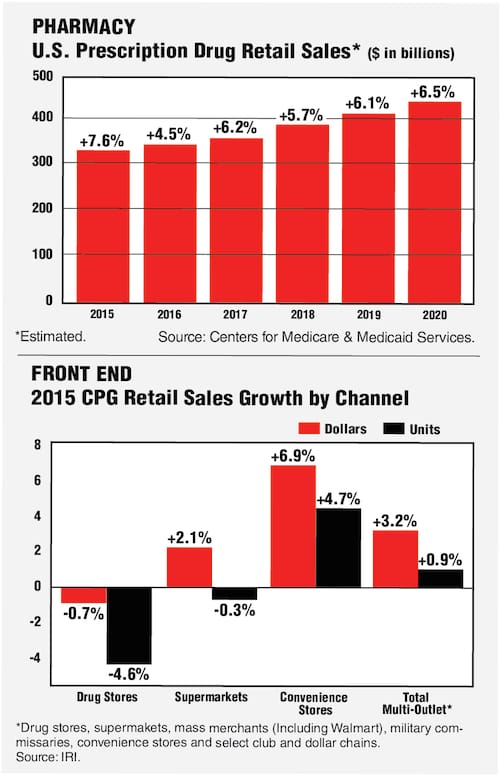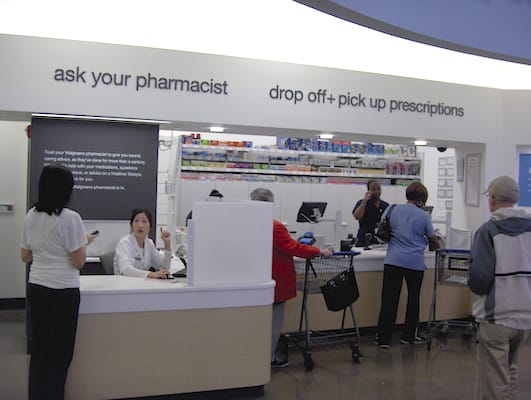NEW YORK — Going forward, chain drug stores can bank on the same underlying trends that have fueled the retail pharmacy business in recent years. But the industry as they’ve known it won’t look quite the same.
Retailer consolidation, changes in drug purchasing and the influx of specialty drugs are reshaping the competitive arena, industry observers say.

Perhaps the top headline in the chain drug sector over the past year has been Walgreens Boots Alliance’s $17.2 billion acquisition of Rite Aid Corp. The deal is slated to close in the second half of this year, pending regulatory approval. If it moves ahead, the industry will go from three national drug chains to two: CVS/pharmacy (9,655 pharmacy locations) and Walgreens (8,173). After them, the next largest pure drug chain in the United States is Kinney Drugs, with 102 stores.
The situation is similar north of the border. Last month, McKesson Corp. announced the purchase of Rexall Health, whose 470 drug stores will join the roughly 2,000 stores of McKesson Canada. Shoppers Drug Mart, acquired by Loblaw Cos. in 2014, remains Canada’s biggest drug chain, with more than 1,300 stores. The nation’s next largest pure-play drug chain is Jean Coutu, with 416 stores.
“As far as drug chain consolidation in the U.S., the last big one left is the Walgreens-Rite Aid merger. There’s a big drop-off in the size of the players after Walgreens and CVS, if Walgreens gets the Rite Aid deal done,” said Joseph Agnese, senior industry analyst at S&P Capital IQ.
Geographic fill-in purchases of small chains and prescription file buys are the most likely share-building opportunities for national operators, he said. “I’m sure that will occur, but it’s not going be significant enough to move the needle for the large drug chains.”
Another possibility is more cross-sector deals like CVS’ acquisition of Target Corp.’s pharmacy business, which brought 1,672 pharmacies into the CVS/pharmacy fold. “That was a bit outside the box, because it wasn’t a traditional drug store chain,” Agnese said. “But it’s something we could potentially see in the future, companies active in M&A trying gain share by getting their products into different channels.”
Thinning profits and reimbursements for prescription drugs have pushed pharmacy retailers and wholesalers to build up scale, he noted. “The industry is facing margin pressure, because more and more people are being covered by large third-party payers, such as Medicaid and Medicare, which are lower-margin businesses. One way to offset that is to reduce your costs. That’s why drug chains are looking to increase scale to get advantages through purchasing and enter into joint ventures with distributors.”
Indeed, with generic drugs dominating dispensing activity, large chains have aligned themselves more closely with drug wholesalers, according to pharmacy supply chain expert Adam Fein, president of Pembroke Consulting.
“Pharmacies and wholesalers have formed these large consortia to change the traditional model of generic drug procurement, but they’re also changing the distribution relationship,” said Fein, who’s also chief executive officer of Pembroke’s Drug Channels Institute. “Some of the big chains that used to buy generics directly have now switched to buying all their generics through wholesalers. And I expect that some of the retailers that haven’t done that are going to make that move soon. So we’re seeing much deeper connections and vertical partnerships emerging in the pharmacy supply chain.”

The overall outlook remains positive for chain drug retailers as prescription usage trends upward, industry analysts say.
Meanwhile, the pharmacy industry is “fundamentally transforming itself” as specialty drugs become a bigger piece of the sales pie and the profit lift from the generics wave diminishes, noted Fein.
“We’re now in an era where specialty drugs are going to be driving the industry’s revenue growth and market structure. The pharmacy industry’s revenue is going to be more than $483 billion by 2020, and specialty drugs are going to account for 44% — or almost half — of that volume,” he explained.
“Retail pharmacies that focus primarily on traditional drugs account for a majority of the dispensed prescriptions but a decreasing share of the industry’s revenue. And competition is forcing retail pharmacies to reduce their prescription profit margins,” Fein said, citing discount drug programs for cash customers, 90-day scripts to compete with mail pharmacies and increased participation in narrow networks.
Last year, CVS Health, Walgreens Boots Alliance, Express Scripts, Walmart, Rite Aid and OptumRx represented about 64% of U.S. prescription dispensing revenue, according to the “2016 Economic Report on Retail, Mail and Specialty Pharmacies” from Drug Channels.
“Many of the largest pharmacies now are centralized mail pharmacies focused on specialty drugs. So the traditional chain is moving into a different kind of business than it has historically been in,” Fein explained. “Many specialty drugs aren’t very well-suited to be in 65,000 retail locations. This is also correspondent with much greater channel control by payers and manufacturers over where drugs get dispensed.
Historically, manufacturers put their drugs into all channels, and payers reimbursed products through all channels. But increasingly, manufacturers are launching specialty products into limited dispensing networks, which may or may not include chains, and payers are limiting the options for where patients can get specialty drugs. So the model is changing, and chain drug stores have to evolve and recognize that it’s a very different world.”
Nevertheless, the overall outlook remains positive for drug chains as prescription usage trends upward, Agnese said.
“We see sales benefiting from increased demand from aging baby boomers and expanded health care coverage following the implementation of the Affordable Care Act,” he observed.
Chain drug stores, too, are on the right track with efforts to enhance their beauty and consumables offerings, expand clinical pharmacy services, open walk-in health clinics, grow their loyalty programs and personalize the shopping experience, according to Agnese, who said those efforts will boost store traffic and basket size in what has been a sluggish front-end sales environment. “Reflecting convenient locations close to consumers’ homes, we believe retail drug stores are better positioned to take market share from nontraditional competitors.”
And though their size puts them at a disadvantage, “smaller pharmacies are still a pretty important part of the industry,” Fein said.
“But the smaller chains need to be mindful of the changes happening in the industry. They need to step back and position themselves according to how manufacturers and payers are changing the drug landscape,” he added. “It’s one of the most challenging transition times for the chain industry that I can recall.”







